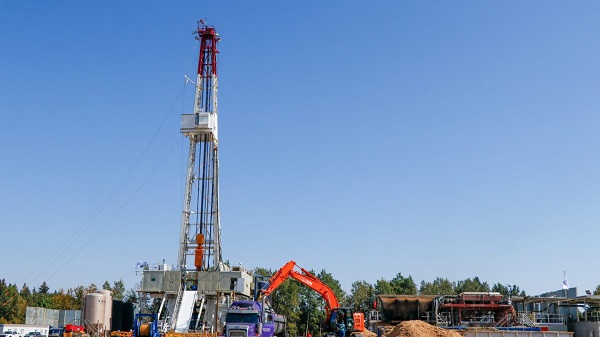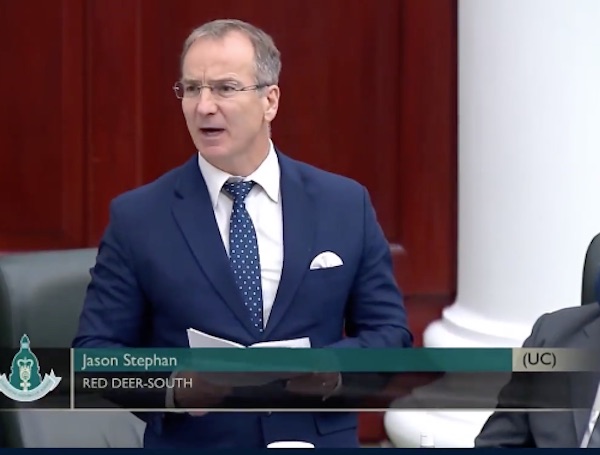Alberta
Red Deer to have a drug treatment court to help break the cycle of crime and addiction

From the Province of Alberta
Supporting recovery and combatting drugs in Red Deer
A new drug treatment court in Red Deer will help support addiction treatment and recovery, while increased support for law enforcement will target drug traffickers and suppliers.
Red Deer will have one of five drug treatment courts outside of Edmonton and Calgary as part of government’s four-year investment of up to $20 million toward expanding the program across the province.
The government is also providing Alberta Law Enforcement Response Teams (ALERT) with a $50-million budget increase for initiatives to disrupt and dismantle organized crime. A portion of this new funding will allow ALERT to expand regional organized crime units across the province, including the addition of three new investigators to the regional unit based in Red Deer.
“Our government will be opening a drug treatment court in Red Deer to reduce crime by offering treatment to those struggling with addiction to help get their lives back on track. We are also ensuring law enforcement in central Alberta have the resources they need to disrupt and dismantle the organized crime groups that traffic and supply the illegal drugs that fuel addiction and take a terrible toll on our communities.”
“Our government has made several important investments in mental health and addiction services across the province over the last year to ensure all Albertans have access to the supports they need to get on the road to recovery. This announcement is no exception. Drug treatment courts are an important way to help Albertans on the road to recovery. We are committed to ensuring people everywhere, including in Red Deer, get the support they need now and in the future.”
“I am pleased that our government has chosen Red Deer as one of the locations for five new drug treatment courts in Alberta. This provides a new avenue for Albertans struggling with substance abuse in central Alberta. I look forward to seeing the positive impact it has on its participants, their families, and our broader community.”
“The City of Red Deer welcomes news that the Government of Alberta has selected our city for a drug treatment court. With the significant public safety and health issues our community and region are facing, this will help to break the systemic cycle of addiction and crime as a much-needed alternative legal mechanism, as well as alleviate backlog pressures currently facing our justice system locally. Additional capacity in the local justice system will also help support the interests of victims of crime.”
Expanding drug treatment courts
Drug treatment courts help break the cycle of crime motivated by addiction by giving people who commit non-violent offences access to judicially supervised treatment and recovery. Treatment is supplemented by frequent drug testing, incentives, sanctions and social services support.
“A drug treatment court in Red Deer will be an integral part of a positive, fundamental course correction in the public interest, providing opportunities for us to support individuals choosing to forsake crime, make restitution, and seek freedom from addictions, while respecting businesses and families in our wonderful community. Better days are ahead.”
“Rehabilitation of offenders is part of the sentencing regime courts must follow. Those people who are motivated to commit offences because of their addiction to drugs are often most in need of rehabilitation. A drug treatment court serving Red Deer and surrounding areas will assist the court in meeting this objective and we very much look forward to this addition to the court in central Alberta.”
“Drug treatment court is the reason I am alive today. I was facing four years in jail for trafficking methamphetamine in Camrose and was so sick and deep into my addiction that my life was falling apart. My children and I were near death. Today, I am proud to say that I continue my life in recovery and advocate for others who struggle with addictions and mental health.”
“Drug treatment court was an integral part of my recovery journey. Like many, I caused a tremendous amount of harm while in active addiction. Without this program, I might not be alive today and I certainly wouldn’t be living a quality life in recovery. I am grateful for this government’s continued expansion of this program so others get the same opportunity for recovery that it gave me.”
“Parents Empowering Parents (PEP) has built a strong partnership with the drug treatment court program over the years. This innovative program and the partnership we’ve built has meant that participants and their families are supported through their long-term recovery. We are excited to hear about the expansion of this program across the province and look forward to seeing its positive impacts.”
“The announcement of the Red Deer Drug Treatment Court is an indication of the innovative and progressive work that Minister Schweitzer has undertaken to combat rural crime in Alberta. Drug treatment courts have proven success in creating the opportunity to change the lives of those who are caught in this cycle of addiction and crime.”
New funding will be used to establish drug treatment courts in five locations outside of Calgary and Edmonton. The court in Red Deer, along with a new program in Lethbridge announced earlier this year, is expected to be operational by late 2021. Three additional sites have yet to be determined.
Drug treatment courts have been operating in Edmonton since 2005 and Calgary since 2007, and part of the $20 million in additional funding is also being used to double the total combined capacity of the two existing courts to about 80 participants a year.
Expanding ALERT
As part of a build-up of regional organized crime units around the province, ALERT is adding three positions to an existing team of 15 investigators based in Red Deer.
“The added resources, and enhancement of our ALERT team in Red Deer, will create more opportunities for collaboration, intelligence sharing, and provide a more versatile response to serious and organized crime in the central Alberta region.”
This move will expand ALERT’s geographic reach in rural areas. It also creates opportunities for investigators from smaller law enforcement agencies to gain experience working on complex cases, which they take back to their respective organizations.
Alberta
Alberta will defend law-abiding gun owners who defend themselves

Alberta’s government will introduce a motion under the Alberta Sovereignty within a United Canada Act to defend law-abiding firearms owners.
A new motion under the Alberta Sovereignty within a United Canada Act will, if passed by the legislature, instruct all provincial entities, including law-enforcement agencies such as municipal police services and the RCMP, to decline to enforce or implement the federal gun seizure program. The motion also makes clear that Albertans have the right to use reasonable force to defend themselves, their families and their homes from intruders.
This builds on the steps Alberta has already taken to reduce crime, strengthen public safety and assert provincial jurisdiction over firearms. This includes passing the Alberta Firearms Act to establish the Alberta Chief Firearms Office, along with the Alberta Firearms Regulation and the Seizure Agent and Provider Licensing Regulation.
“It’s time for Ottawa to stop targeting the wrong people. Albertans have the right to protect their homes and their families. No one should hesitate to defend themselves when faced with a threat at their own doorway. Law-abiding citizens, hunters, farmers and sport shooters are not the source of violent crime, yet the federal government wants to confiscate their property while illegal guns pour across our borders. Alberta will not stand by while responsible gun owners are treated like criminals. This motion is about using every legal tool we have to protect their rights, uphold public safety and push back on federal overreach into provincial jurisdiction.”
“When someone breaks into your home, the law recognizes that you have enhanced rights to protect yourself and your family. Alberta is making that principle unmistakably clear: lawful, reasonable self-defence will be respected, not criminalized.”
“As an experienced former law enforcement officer, law-abiding gun owners have never been an issue, in my own personal experience, nor has there been any data to support that law-abiding gun owners are the ones that are committing violent gun crimes. The illegal guns that you see being used by criminals are typically being smuggled in from the United States. The federal government should help us strengthen the border, helping us to stop illegal guns from coming into Canada. This would further enhance safety and security for the people of Alberta and Canada as opposed to going after lawful gun owners.”
Under the Alberta Firearms Regulation, municipalities, law enforcement and police commissions must obtain approval from Alberta’s Minister of Justice before accepting funding to participate in the Assault-Style Firearms Compensation Program.
“Misguided federal initiatives such as the handgun transfer ban and the Order in Council firearms prohibitions of 2020, 2024 and 2025 have had a devastating impact on the safe, legitimate activities of the firearms community and the businesses that support it, while having no discernible effect on criminal activity. I am proud to see that the Alberta government is pushing back and supporting lawful firearms owners through these measures.”
“Licensed gun owners and all Albertans can rest assured that their government, under the leadership of the UCP, is laser focused on protecting law abiding citizens while prioritizing real public safety.”
“The Alberta Hunter Education Instructors Association will continue to support our government and the Alberta chief firearms officer in our joint quest to use safety training and education as the key tools to ensure we have safer streets and communities. Safe and responsible use of firearms in Alberta is a key part of our heritage, culture, and our rich and precious heritage.”
Key facts:
- Pursuant to the Attorney General’s recent guidance protocols, Alberta’s prosecutors will decline to prosecute offences under the federal gun seizure program when it is not in the public interest.
- The Attorney General’s recent guidance protocol directs prosecutors to not prosecute home defence offences when it is not in the public interest.
- Total spending on the federal Assault-Style Firearms Compensation Program is expected to exceed $750 million.
- The firearms motion considers the Alberta Bill of Rights, the Constitution Act, 1867 and the Criminal Code.
- Currently 10 per cent of adult Albertans are licenced to use and own firearms. There are 381,900 firearms licences in Alberta.
- Alberta has 638 licensed firearms businesses, 138 shooting ranges and 91 shooting clubs.
Alberta
Emissions Reduction Alberta offering financial boost for the next transformative drilling idea

From the Canadian Energy Centre
$35-million Alberta challenge targets next-gen drilling opportunities
‘All transformative ideas are really eligible’
Forget the old image of a straight vertical oil and gas well.
In Western Canada, engineers now steer wells for kilometres underground with remarkable precision, tapping vast energy resources from a single spot on the surface.
The sector is continually evolving as operators pursue next-generation drilling technologies that lower costs while opening new opportunities and reducing environmental impacts.
But many promising innovations never reach the market because of high development costs and limited opportunities for real-world testing, according to Emissions Reduction Alberta (ERA).
That’s why ERA is launching the Drilling Technology Challenge, which will invest up to $35 million to advance new drilling and subsurface technologies.
“The focus isn’t just on drilling, it’s about building our future economy, helping reduce emissions, creating new industries and making sure we remain a responsible leader in energy development for decades to come,” said ERA CEO Justin Riemer.
And it’s not just about oil and gas. ERA says emerging technologies can unlock new resource opportunities such as geothermal energy, deep geological CO₂ storage and critical minerals extraction.
“Alberta’s wealth comes from our natural resources, most of which are extracted through drilling and other subsurface technologies,” said Gurpreet Lail, CEO of Enserva, which represents energy service companies.
ERA funding for the challenge will range from $250,000 to $8 million per project.
Eligible technologies include advanced drilling systems, downhole tools and sensors; AI-enabled automation and optimization; low-impact rigs and fluids; geothermal and critical mineral drilling applications; and supporting infrastructure like mobile labs and simulation platforms.
“All transformative ideas are really eligible for this call,” Riemer said, noting that AI-based technologies are likely to play a growing role.
“I think what we’re seeing is that the wells of the future are going to be guided by smart sensors and real-time data. You’re going to have a lot of AI-driven controls that help operators make instant decisions and avoid problems.”
Applications for the Drilling Technology Challenge close January 29, 2026.
-

 National1 day ago
National1 day agoMedia bound to pay the price for selling their freedom to (selectively) offend
-

 Business1 day ago
Business1 day agoIs there a cure for Alzheimer’s Disease?
-

 Bruce Dowbiggin1 day ago
Bruce Dowbiggin1 day agoSometimes An Ingrate Nation Pt. 2: The Great One Makes His Choice
-

 Alberta1 day ago
Alberta1 day agoNew era of police accountability
-

 C2C Journal1 day ago
C2C Journal1 day agoLearning the Truth about “Children’s Graves” and Residential Schools is More Important than Ever
-

 Energy2 days ago
Energy2 days agoCanadians will soon be versed in massive West Coast LPG mega-project
-

 Artificial Intelligence2 days ago
Artificial Intelligence2 days ago‘Trouble in Toyland’ report sounds alarm on AI toys
-

 Brownstone Institute1 day ago
Brownstone Institute1 day agoThe Unmasking of Vaccine Science






